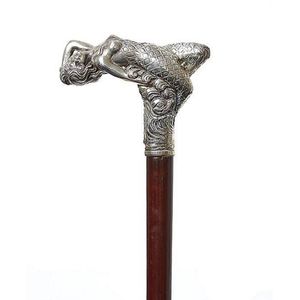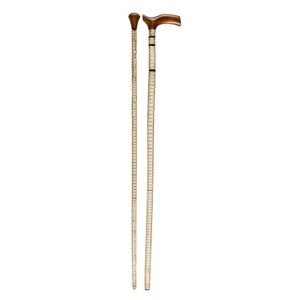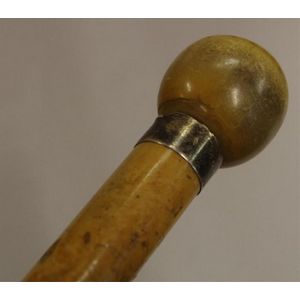
19th Century Silver-Mounted Carved Beech Walking Cane
A silver mounted carved English beech walking cane, 19th century, 92.5 cm

19th Century Ivory 'Three Friends' Wrist Rest
An ivory 'three friends' wrist rest, 19th century, naturalistically carved in the form of a hollowed section of a pine trunk, the gnarled convex surface with a branch of pine needles, flowering prunus and bamboo canes in high relief extending over the…

Golf Club Handle Vintage Walking Cane
Vintage Gentleman's walking cane, with golf club handle, 89 cm long approx.

Victorian Rose Gold Topped Walking Stick, London 1860
Antique Victorian 9ct rose gold topped formal evening cane/ walking stick marks partially rubbed London, 1860

Swirled Art Glass Walking Cane - Vintage Condition
Vintage solid art glass walking cane with swirl patterns. Condition minor wear. Length 103 cm

Victorian Silver and Ivory Walking Stick with Provenance
A late Victorian silver, ivory and malacca cane walking stick, the approximate T-form ivory handle with decorative embossed silver cap ends and fitting to the tapered malacca shaft, engraved 'W.S.' reputedly a presentation upon the achievement of becoming…

Amber Art Glass Walking Cane with Blown Handle
Vintage amber art glass walking cane with a blown handle & twisted stem, hollow to the centre. Condition good, minor wear the base. Length 105 cm

Ivory Monkey Carved Walking Cane with Gold Collar (Repair)
Ivory handled walking cane the handle carved with monkey, gold collar (repair)

19th Century Whale Bone Spiral Walking Cane
A whale bone baleen spiral carved walking cane, 19th century, 78 cm long

Ivory, Whalebone, and Tortoiseshell Walking Stick with Inlay
Ivory, whale bone & tortoiseshell walking stick having an ivory twist handle, with a whalebone cane with tortoiseshell inlay throughout. Condition, good to fair, some loose inlay, length, 84 cm

Sterling Silver Malacca Cane by Crown Jewellery Co
Sterling silver malacca cane, crown Jewellery Co for Walker and Hall

Antique Ivory Cane with Engraved Silver Cap
Old Ivory cane with brass ferule and silver cap with early hand engraved initials. The cap has possibly been lacquered and there is some minor repairs to cane, approx 90 cm long

19th Century Ivory Cane with Foliate Engraved Mount
A 19th century ivory cane, with a faceted foliate engraved binchbeck mount to the top, above two holes for a cord strap, metal mount to the tip, (natural age hairlines to the ivory, wear and dents to the pinchbeck mount), 94 cm wide

Blue Glass Candy Stripe Walking Cane
An end of day blue glass walking cane with applied white candy stripe decoration

Silver Topped Walking Cane with Engraved Details
A gentleman's walking cane with silver repousse top, engraved to the top 'D.A Rang Wala', with buckle band on shaft engraved 'ADE' in script. Silver is unmarked. Height 88 cm

Sterling Silver Collared Snakewood Walking Cane, 1924 London Hallmark
Snakewood & carved ivory walking cane with sterling silver collar hallmarked London 1924, 90.5 cm long

Antique Sterling Silver & Vintage Walking Sticks
Antique sterling silver and cane walking stick, hallmarked Birmingham 1902, together with two other vintage cane walking sticks

Antique Whale Bone Walking Cane with Tooth Handle
A fine antique whale bone walking cane, 19th century, the heavy cane with a spiral twist relief carved motif to the length with a crossed hatched upper section to a brass ferrule, the handle of turned whale tooth and having a compressed spherical screw…

Antique 18ct Gold Topped Walking Cane - Dented
19th century hallmarked 18ct gold topped walking cane. Dents to top. Length 91 cm

Marine Ivory Fist & Viper Walking Cane
Marine ivory carved rosewood walking cane depicting a clenched fist holding a viper with a rope twist cuff. Condition good, age related wear. Length 92 cm

Hallmarked Sterling Silver Topped Walking Cane, London 1919
English hallmarked sterling silver topped hard wood walking cane London, 1919, maker Wf. Condition good to fair, wear to the handle, loss to the base. Length 91 cm

Art Nouveau Silver Mermaid Walking Cane
A German Art Nouveau silver mounted Guiana Snakewood walking cane, circa 1900, the 800 silver handle depicting a recumbent mermaid supported by waves, the tapered shaft with silver ferrule, probably made in Schwabisch Germany, approximate weight of handle…

Ivory Masked Cane and Parasol Handle
Ivory walking cane handle with mask head and an ivory parasol or umbrella handle

19th Century Anglo-Indian Malacca & Ivory Walking Cane
A carved malacca & ivory topped walking cane, Anglo-Indian, 19th century. 88 cm long.

Mogul Indian Lapis Lazuli Walking Cane, 19th Century
A fine lapis lazuli walking cane with silver collar, most likely Mogul Indian, 19th century. 77 cm high

Antique Narwhal Tusk & Silver Walking Cane
An antique Narwhal tusk and silver walking cane, later 19th century, the cane of traditional tapering form and brass capped to the base, a turban style handle in possibly walrus ivory, the sterling silver collar with inscription dated 1883. Length 85 cm

Silver Topped Walking Cane with Concealed Parasol
Walking stick: unusual 19th century silver topped walking cane with a seperate concealed parasol under the cap. 90 cm

Silver Mounted Blackwood Walking Canes from Australia
Three silver mounted blackwood walking canes, Australia, 19th/20th century, the tallest 89 cm

Victorian Candy Glass Walking Cane (9 words)
A Victorian candy glass walking cane, 19th century, 116 cm

19th Century Whalebone Walking Canes with Carvings
Two carved whalebone wooden mounted walking canes, 19th century, the tallest 89 cm

Shark Vertebrae Walking Canes, 19th Century
Two shark vertebrae walking canes, 19th century, the longest 83 cm

Whalebone cane with hidden gambling die, 19th century
A carved whalebone walking cane with screw-top hidden compartment containing a gambling die, 19th century

19th Century Whalebone Walking Canes (8 words)
Two ornately carved whalebone walking canes, 19th century, the tallest 90 cm

19th Century Whalebone Walking Canes (or) Carved Whalebone Canes
Two carved whalebone walking canes, 19th century, the tallest 85 cm

Ivory Bulldog Head Antique Walking Cane (8 words)
Antique walking cane with caved ivory bulldog head to top. Fine quality, C:1870

Embossed Silver and Malacca Walking Cane, 19th Century
An embossed silver and Malacca walking cane, English, 19th century. 89 cm long.

1930's Car Molded Ebony Walking Cane with Silver Mounts
A silver mounted ebony walking cane, moulded with a 1930's era car, 20th century. 88 cm high

Silver Mounted Ebony Racing Horse Walking Cane
A silver mounted ebony walking cane, moulded with racehorses, 20th century. 90 cm

Silver Mounted Ebony Racing Cane
A silver mounted ebony walking cane, moulded with racehorses, 20th century. 90 cm high

1820 Seaman's Whaling Cane - Rare Antique
Rare antique seamans walking cane, from a whaling ship, C:1820

French Silver & Enamel Walking Cane, c.1850
Antique French silver & enamel walking cane, with snake wood shelf, c:1850

Horse Measuring Walking Stick & Riding Crops
Walking Stick Cum Horse Measuring Rule, cane walking stick with metal handle engraved 'E.J.Barton', the handle pulls out to reveal a ruler for measuring the height of horses, with scales in hands, inches & metric, made by 'Ashford, Maker to the Queen'.…

19th Century Whalebone and Wood Cane
A whalebone baleen and turned wood cane, 19th century. 81 cm long

19th Century Whalebone and Carved Wood Cane
A whalebone baleen and carved wood cane, 19th century turned fish scale and spiral carved. 83 cm long

19th Century Whalebone Walking Cane
A fist carved whalebone walking cane, 19th century. 85.5 cm long

Rare Indian Crystal and Emerald Walking Cane
A rare rock crystal, emerald gold and silver set ebonised walking cane, Indian, 19th century. 90.5 cm long

1840 Marine Ivory Deer Head Walking Cane
Antique walking cane with marine ivory deer head, on mallaca shaft, circa 1840. 81 cm long

Indian Ebony Cane Walking Stick, 1870s
Ebony with cane Indian walking stick, Circa 1870s. 92 cm long

Burrwood Walking Cane with Parrot Handle and Silver Collar
An English walking cane, by Jonathan Howell of Henry Howell & Co, circa 1921, the burrwood shaft terminating in silver collar and carved parrot form handle, retailed by J.L.Caldwell Philadelphia

Bullet & Dog Handle Walking Canes
'Trench Art' walking cane, brass mounts, bullet handle & ebony 'Dog' handled walking cane with silver collar, approx 85 cm & 87 cm long (2)

Antique Walking Canes with Silver Mounts and Engravings
Three walking canes, one with Indian silver mounts. One with engraved silver mounts, maker 'Kingston & Co', engraved 'Hal From Fred, Xmas '98'. One with engraved handle, hallmarked Birmingham 1885. Approx 84 cm, 97 cm & 102 cm long (3)

Antique Walking Canes with Gilt and Silver Mounts
Three walking canes. One with gilt metal mount, one with silver top with engraved decoration, one with engraved silver top hallmarked Birmingham 1888. Approx 95 cm, 95 cm & 114 cm (3)

Three Antique Silver Walking Canes with Hallmarks
Three silver mounted walking canes, hallmarked London 1897, 1908 & 1914, approx 80 cm, 82 cm & 85 cm long (3)

Antler Handled Walking Canes with Metal Collars (2)
Two antler handled walking canes with metal collars, approx 88 cm & 89 cm long (2)

Pair of Silver Capped Walking Canes
Two silver capped walking canes, one with engraved decoration, Continental silver marks, one stamped 'Sterling Silver'. Approx 86 cm & 91 cm long (2)

Silver Mounted Walking Canes with Bone Handle
Two silver mounted walking canes, one with a bone handle. Approx 88 cm long for both (2)

Dunhill Silver Walking Cane with Jade Handle (London 1980)
Dunhill silver mounted walking cane with jade insert handle, hallmarked London 1980 stamped Dunhill. Approx 91 cm long

Engraved Sterling Silver Walking Canes - Trio Collection
Three sterling silver topped walking canes, all with engraved decoration, hallmarked London 1901 maker WHR, Birmingham 1876 maker Sydney & Company, one unmarked, approx 80 cm to 90 cm long (3)

19th Century Horn Handle Walking Canes (Set of 4)
Four 19th century walking canes, horn handle, metal mounts (4)

Victorian Mouse Carved Walking Cane
A Victorian horn and silver walking cane, 1888 Birmingham, with maker's mark WM, the tapering malacca cane shaft with a scrolled silver ferrule surmounted by a cream brown mottled bone handle well carved with a pair of mice; hallmarked. Length 85 cm

19th Century Ivory-Handled Malacca Walking Cane Collection
A collection of five 19th century walking canes, one Malacca exampled with carved ivory handle, 88 cm long

Horn and Timber Walking Cane with Rubber Stopper
Tusk, horn and timber walking cane with a rubber stopper. Length 98 cm

Ivory Tiger Cane Finial with Rock Draping
Carved ivory cane finial tiger draped over rock, 6 cm height (slight chip to ear)

French Ivory Pointing Stick with Carved Floral Monogram
A French ivory handled Pointing stick, late 19th century, having a smooth tapering ivory handle terminating in a relief carved floral spray enclosing a monogram, the cane proper made of noduled bamboo with a carved point. Length 65 cm

Whalebone and Antler Cane
Early whalebone and antler cane. Whalebone stem with antler handle and metal collar. Length 87 cm

Baleen and Wood Cane by M.A.d'Avanzo, 19th Century
A whalebone, baleen and turned wood cane, 19th century, labelled M.A.d'.Avanzo, Queensland, 84 cm long

19th Century Faceted Whalebone Cane - 84cm Long
A turned and faceted whalebone cane, 19th century, 84 cm long

19th Century Whalebone Carved Walking Cane
A whalebone and baleen fish scale carved walking cane, 19th century, 82 cm long

Whalebone and Shark Vertebrae Cane (1900)
A whalebone and shark vertebrae cane, circa 1900, 89 cm long

Silver Mount Whale Tooth Walking Cane, c. 1900
A silver mounted whales tooth walking cane, circa 1900, 90 cm long

Miniature Telescope Walking Cane, 19th Century
A brass, silver, ebony and snooker ball miniature telescope walking cane, 19th century, 82 cm high

Whalebone Silver Ebony Cane, 19th Century
A whalebone, silver and ebony cane, 19th century, 92 cm long

19th Century Whalebone Carved Cane
A whalebone white metal and incised carved cane, 19th century, 79.5 cm long

19th Century Whalebone Carved Cane (8 words)
A whalebone turned and carved cane, 19th century, 81 cm long

19th Century Whalebone and Wood Carved Cane
A whalebone baleen and carved wood cane, 19th century, turned ridded fish scale and spiral carved, 83 cm long





















 Loading more...
Loading more...